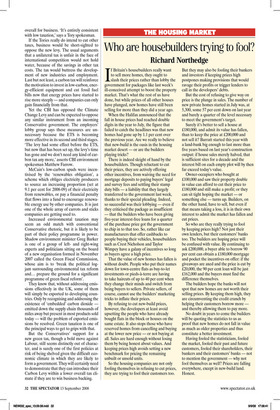Who are housebuilders trying to fool?
Richard Northedge
If Britain’s housebuilders really want to sell more homes, they ought to slash their prices rather than lobby the government for packages like last week’s ill-conceived attempt to boost the property market. That’s what the rest of us have done, but while prices of all other houses have plunged, new homes have still been selling for more than they did a year ago.
When the Halifax announced that the fall in house prices had reached double digits in the year to July, the figure that failed to catch the headlines was that new homes had gone up by 1.1 per cent over the previous year. Are we really to believe that new-build is the oasis in the housing market desert — or are the builders playing tricks?
There is indeed sleight of hand by the housebuilders. Though reluctant to cut their prices, they are actively offering other incentives, from waiving the need for mortgage deposits to paying buyers’ legal and survey fees and settling their stamp duty bills — a liability that they largely transferred to the government last week, thanks to their special pleading. Indeed, so successful was their lobbying — even if they criticised the package as insufficient — that the builders who have been giving five-year interest-free loans for a quarter of the purchase price got the government to chip in to that too. So, rather like car manufacturers that offer cashbacks to people buying their vehicles, housebuilders such as Crest Nicholson and Taylor Wimpey have a galaxy of incentives so long as buyers agree a high price.
That the value of new homes has fallen is without doubt. People who put their names down for town-centre flats as buy-to-let investments or pieds-à-terre are having to take haircuts of up to 40 per cent when they change their minds and switch from being buyers to sellers. Private sellers, of course, cannot use the builders’ marketing tricks to inflate their prices.
By refusing to cut new-build prices, however, the developers at least avoid upsetting the people who have already bought flats in the block or houses on the same estate. It also stops those who have reserved homes from cancelling and buying at the lower new price — or not buying at all. Sales are hard enough without losing them by being honest about values. And keeping prices high avoids setting a new benchmark for pricing the remaining unbuilt or unsold units.
So the housing companies are not only fooling themselves in refusing to cut prices, they are trying to fool their customers too. But they may also be fooling their bankers and investors if keeping prices high postpones making provisions that would ravage their profits or trigger lenders to call in the developers’ debts.
But the cost of refusing to give way on price is the plunge in sales. The number of new private homes started in July was, at 5,300, some 57 per cent down on last year and barely a quarter of the level necessary to meet the government’s target.
Surely it’s better to sell a house at £180,000, and admit its value has fallen, than to keep the price at £200,000 and not sell it? Barratt started this year with a land-bank big enough to last more than five years based on last year’s construction output: if house sales merely halved, that is sufficient sites for a decade and the interest bill on each empty plot will by then far exceed today’s value.
Owner-occupiers who bought at £100,000 and saw their property double in value can afford to cut their price to £180,000 and still make a profit; or they can sit tight hoping the market — or something else — turns up. Builders, on the other hand, have to sell, but even if that means taking a loss, it is in their own interest to admit the market has fallen and cut prices.
So who are they really trying to fool by keeping prices high? Not just their own lenders, but their customers’ banks too. The builders are hoping price will be confused with value. By continuing to ask £200,000, a buyer able to borrow 90 per cent can obtain a £180,000 mortgage and pocket the incentives on offer: if the giveaways are axed and the price is cut by £20,000, the 90 per cent loan will be just £162,000 and the buyers must find the difference themselves.
The builders hope the banks will not spot that new homes are not worth their selling prices. By keeping them high, they are circumventing the credit crunch by helping their customers borrow more — and thereby allowing them to pay more.
No doubt in years to come the builders will be quoting the statistics to us as proof that new homes do not fall in value as much as older properties and thus constitute a better investment.
Having fooled the statisticians, fooled the market, fooled their past and future customers, fooled their shareholders, their bankers and their customers’ banks — not to mention the government — why not fool themselves as well? Prices are falling everywhere, except in new-build land. Honest.










































































 Previous page
Previous page